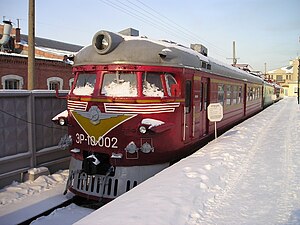SŽD series ЭР10
| SŽD series ЭР10 (ER10) | |
|---|---|
|
Head carriage from the ER10.002
|
|
| Numbering: | ЭР10.001-006 |
| Number: | 6 units (4-car unit) 24 cars |
| Manufacturer: |
Rīgas Vagonbūves Rūpnīca Riga Electrical Machine Plant Tver Wagon Factory |
| Year of construction (s): | 1960-1961 |
| Retirement: | 1974 |
| Gauge : | 1,520 mm |
| Length over coupling: | 24,200 mm (1 trolley) |
| Service mass: | 65.7 t ( control car ) 40 t (intermediate car) |
| Top speed: | 130 km / h |
| Continuous output : | 4,000 kW (1 motor vehicle) |
| Power system : | 3 kV direct current |
| Power transmission: | Overhead line |
| Number of traction motors: | 4 (motor vehicle) |
| Brake: |
Pneumatic brake Resistance brake |
| Seats: | 112 ( control car ) 131 (intermediate car) |
The ЭР10 ( ER10 ) is a multiple unit built by the Rigaer Waggonfabrik (RVR) in Latvia , which was used specifically for suburban traffic. It belongs to a series of electric multiple units for direct current drive with a drag brake and an increased length of the box. It can be called a transition pattern for the ЭР22 series.
history
In 1960 two new 4-wagon electric trains were delivered, which were given the designation ЭР10 ( ER 10 ). The vehicles were made by Rīgas Vagonbūves Rūpnīca (the motor vehicles), the Tver wagon factory (the sidecars) and the Riga electrical engineering works , which supplied the electrical equipment. An electric train consisted of a non-powered control car , a powered intermediate car , a powered intermediate car and another non-powered control car. Two of these electric trains could be combined into an 8-car train.
The box of the vehicles had over the delivered vehicles then turn ЭР1 and ЭР6 significant differences. The length of the box for the vehicles was 24.5 m. In the middle of the car was a third anteroom. The electrical equipment did not differ much from the ЭР6 vehicles . The bogies and drives, on the other hand, experienced almost no changes. The motor vehicles had the electric drive motors ДК-106А-2 ( DK-106A-2 ), they had, in contrast to the ДК-106А ( DK-106A ), an enlarged wire cross-section to prevent overheating of the wires and a number of other insignificant changes. In comparison with the ЭР6 series electric trains , the number of levels of excitation weakening has increased from four to six. This made it easier for the train to start up. The braking equipment, on the other hand, was completely identical to that of the ЭР6 series. In addition, a number of other changes have been made to the design. Obviously, the vehicles were created at a time when the configuration of the new trains was not yet completely clear, and this series was a modification of the ЭР1 series .
The total mass of the 4-car train was 207.8 t. The number of seats in the entire train was 486. Just as the power of the traction motors remained unchanged compared to the ЭР6 series and the mass was increased at the same time, the specific power was logically reduced a little. However, due to the removal of the pole warming through the enlarged lines, the acceleration relay had a value of 330 A compared to the original 285 A, so the speed of the train remained practically unchanged compared to the ЭР6 .
Each 4-car train had its own number, the individual cars in the sections with odd numbers (001, 003, 005) were given the numbers 1-4, the cars in the sections with even numbers (002, 004, 006) were given the numbers 5-8, which had the background that two 4-wagon trains ran together during operation.
A total of six 4-wagon trains were built between 1960 and 1961, which could be combined into three 8-wagon trains in operation. The trains were assigned to the Pererwa depot and went on the direction to Kursk and Isredka of the Moscow railway junction . In 1974 they were retired due to spare parts that were no longer available.
At the moment only a few wagons of trains have survived. The head car of the train ЭР10.002 ( ER10.002 ) with the number 06 has been preserved in good condition . It stood for some time in the Moscow - Kursk depot of the Moskovskaya seleznaja doroga and is now in the Warsaw Railway Museum in Saint Petersburg . In the case of this vehicle, the authenticity of the parts of the vehicle has not been proven; the salon was put together by volunteers from a decommissioned ЭР1 , the same applied to parts of the driver's cab. Some of the ЭР10 wagons were discovered in the Uslowaya depot . Another head wagon was in the Oscherelje depot until 2011, when it was scrapped there in September of the same year.
See also
literature
- Rakov W. А. Моторвагонные секции серии ЭР10 // Локомотивы отечественных железных дорог 1956 - 1975. - М .: Транспорт, 1999. - Pages 23-4 .
